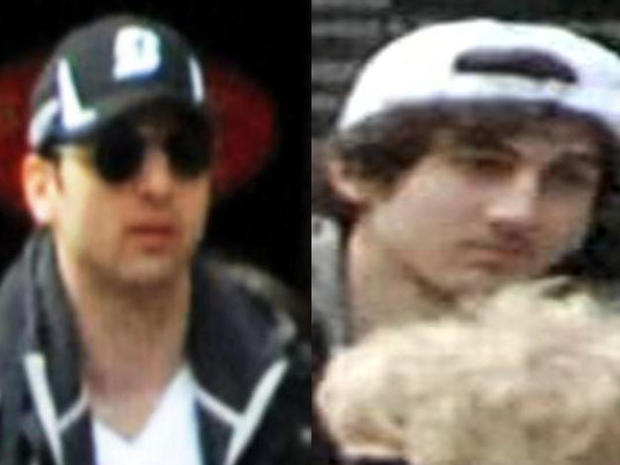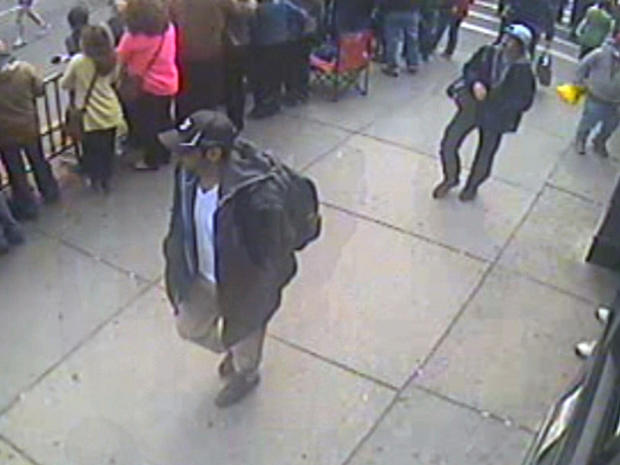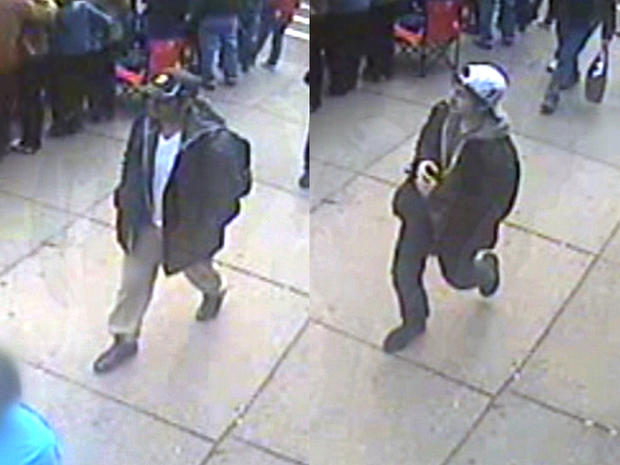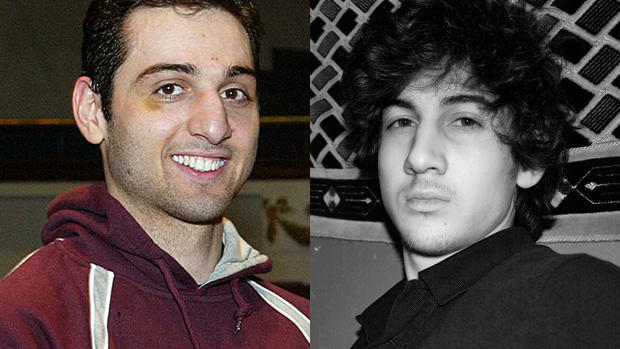FBI releases video of 2 Boston bombing suspects
Updated 10:10 PM ET
BOSTON Plucking a couple of faces in baseball caps out of a swarming crowd, the FBI zeroed in on two suspects in the Boston Marathon bombing and shared surveillance-camera images of them with the world Thursday in hopes the public will help hunt them down.
The somewhat blurry but still detailed photos and video depict one young man in a dark cap and another in a white cap worn backward, both wearing backpacks and one walking behind the other on the sidewalk near the finish line as marathoners run by.
The man in the white hat was seen setting down a backpack at the site of the second explosion, said Richard DesLauriers, FBI agent in charge in Boston.
"Somebody out there knows these individuals as friends, neighbors, co-workers or family members of the suspects," he said. "Though it may be difficult, the nation is counting on those with information to come forward and provide it to us."
- Cell phone logs may ID mystery man in Boston bomb video
- Bombing investigators focus on possible suspect in surveillance video
- Complete coverage: Bombing Marathon bombings
They looked much like typical college students, but DesLauriers described them as armed and extremely dangerous, and urged anyone who sees or knows them to tell law enforcement and "do not take any action on your own."
The photos of the suspects can be seen online on fbi.gov. Any tips regarding the suspects can be called into the FBI at 1-800-CALL-FBI or send via the Web at bostonmarathontips.fbi.gov. Sources say investigators have leads on possible names, CBS News correspondent Bob Orr reported, but DesLauriers said the FBI still needs help.
CBS News has learned that FBI is reporting record traffic on its web sites as people go online to view stills and video of the suspected Boston bombers. The FBI is also getting an extremely high number of phone calls and emails.
Authorities believe both baseball caps have logos that are Bridgestone Golf.
Investigators had been focusing on a man wearing a white baseball cap seen dropping off a bag, and then walking away from the site of the second of two deadly explosions. Orr reported that investigators were able to retrace his steps and discovered video of the man with another man carrying a backpack.
The surveillance footage was released three days after the attack that left three people dead, wounded more than 170, and cast a dark shadow over one of this city's most joyous traditions.
Orr reported that after releasing the video, the FBI is hoping for tips that will identify the suspects. Investigators are using facial recognition software; scouring criminal databases; and trying to to find a match. They have some potential names for these suspects but they are currently unable to match.
As for whether this was an act of either foreign or domestic terrorism, Orr posed that question to a senior federal official, who said right now they think they are leaning-- and he emphasizes they don't have a definite-- that they are leaning more towards a domestic attack.
The FBI video is a compilation of segments, altogether about 30 seconds long. The planting of the backpack, as described by authorities, was not part of the footage made public.
CBS News correspondent John Miller explained why these two people are believed by the FBI to be possible suspects: "They have other video, including the one Orr referenced, where they believe they actually have on tape one of the suspects in the white baseball cap putting the bomb down in front of the Starbucks at the second location. But reason they selected the pictures we're seeing here is they wanted to find the pictures that didn't have the most sinister activity but the pictures that gave people the best chance of recognizing them."
The man in the dark hat was dubbed Suspect 1 by the FBI and appeared to be wearing sunglasses. The other, in the white hat, was labeled Suspect 2. Both appeared to be wearing dark jackets. The FBI did not comment on the men's height, weight or age range and would not discuss their ethnicity.
"It would be inappropriate to comment on the ethnicity of the men because it could lead people down the wrong path potentially," said FBI agent Greg Comcowich, a spokesman for the Boston FBI office.
The enlarged pictures of white-hatted Suspect 2 in profile and head-on were blurry but still remarkable in their detail — and more revealing than those of Suspect 1.
While authorities said the information on the men began coming together over the previous day or so, agent Daniel Curtin said the FBI did not release the photos earlier because "it's important to get it right."
Distribution of the images brought both encouragement and unease to some Bostonians.
Jennifer Lauro of Topsfield, Mass., worried that the photos might breed fear and suspicion.
"It just looks like a college kid, so I think that's going to make people feel vulnerable," she said. "Because it could be anybody. It looks like any kid from Boston College or Boston University or any other school."
Earlier Thursday, President Barack Obama paid a visit under heavy security to offer reassurance to the city and a warning to those responsible for the attack: "We will find you."
At an interfaith service honoring the three people killed and more than 180 wounded in Monday's twin blasts, the president sought to inspire a stricken city and comfort an unnerved nation, declaring that Boston "will run again."
"We may be momentarily knocked off our feet," Obama said at the Roman Catholic Cathedral of the Holy Cross. "But we'll pick ourselves up. We'll keep going. We will finish the race."
The crowd applauded as Obama warned those who carried out the attack: "Yes, we will find you. And, yes, you will face justice."
There was a heavy police presence around the cathedral as residents lined up before dawn, hoping to get one of the roughly 2,000 seats inside. By 9 a.m., they were being turned away.
Among those who couldn't get a ticket was 18-year-old Eli Philips. The college student was a marathon volunteer and was wearing his volunteer jacket. He said he was still shocked that "something that was euphoric went so bad."
Ricky Hall of Cambridge showed up at 8 a.m. but was turned away from the line to get inside that was already stretching down at least two city blocks.
"I came to pay my respects to the victims," he said. He said he was also angry that someone would desecrate the marathon, and he urged maximum punishment for the perpetrators.
Massachusetts Gov. Deval Patrick said he shared the frustration that those responsible were still at large, but he said solving the case will not "happen by magic."
"It's going to happen by doing the careful work that must be done in a thorough investigation," Patrick said. "That means going through the couple of blocks at the blast scene square inch by square inch and picking up pieces of evidence and following those trails, and that's going to take some time."
The bombs were crudely fashioned from ordinary kitchen pressure cookers packed with explosives, nails and ball bearings, investigators and others close to the case said. Investigators suspect the devices were then hidden in black duffel bags and left on the ground.
Seven bombing victims remained in critical condition.
Dr. Peter Burke, chief of trauma surgery at Boston Medical Center, said Thursday that one of the youngest victims, a 5-year-old boy is getting better and "is going to be OK." A blast can often compress a child's chest, bruising the lungs and heart, he said, adding he is pleased with the boy's progress.
Dozens of victims have been released from hospitals, and officials at three hospitals that treated some of the most seriously injured said they expected all their remaining patients to survive.
The blasts killed 8-year-old Martin Richard of Boston, 29-year-old Krystle Campbell of Medford, and Lu Lingzi, a Boston University graduate student from China.
Video and photos recovered in the investigation are being examined and enhanced by an FBI unit called the Operational Technologies Division, said Joe DiZinno, former director of the FBI lab in Quantico, Va.
Investigators are looking at video frame by frame -- a laborious process, though one aided by far more sophisticated facial recognition technology than is commercially available, forensic specialists said.
"When you have something that is this high-profile, they are going to use every available resource that they have," said former Miami federal prosecutor Melissa Damian Visconti.
The investigation will probably collect about a million hours of videotape from fixed security cameras and cellphones and cameras used by spectators, said Gene Grindstaff, a scientist at Intergraph Corp., a Huntsville, Ala., company that makes video analysis software used by the FBI and other law enforcement agencies.
But after years of investigating terrorist incidents and other crimes, the FBI is practiced at cataloging, categorizing and analyzing such evidence and will winnow it down dramatically, he said.
"Back in the days of 20 years ago, you were lucky if you had video and it was probably of poor quality and it took a tremendous amount of enhancement. Today you have a completely different issue," Grindstaff said.
Investigators can set the video analysis software so that it automatically searches for certain types of objects or people matching a height and weight description. The software can also spot patterns that analysts might not notice, such as a certain car that turns up in different places, Grindstaff said.
DiZinno, who ran the FBI lab from 2007 to 2010, said any retrieved bomb components such as the pressure cookers, shrapnel and pieces of timers or wire will be closely examined for fingerprints, DNA, hairs and fibers.
The bomb components would be traced by figuring out the item's maker, where each piece is typically purchased and whether the device resembles any bombs the FBI has seen in past attacks. The FBI lab keeps a detailed file on past bombings, including many overseas attacks.
"Let's say there was a timer," DiZinno said. "Was there a serial number? Who was the manufacturer? That can provide leads for investigators."
One pressure cooker maker, the Fagor Group in Spain, said that it has been contacted by U.S. investigators and that company officials are extending full cooperation. The company sells 250,000 pressure cookers a year in the U.S. and 1 million worldwide.





